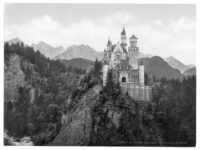Vintage: Historic B&W photos of Baden, Germany (1890s)
The margraves of Baden originated from the House of Zähringen. Baden is named after the margraves’ residence, Hohenbaden Castle in Baden-Baden. Hermann II of Baden first claimed the title of Margrave of Baden in 1112. A united Margraviate of Baden existed from this time until 1535, when it was split into the two Margraviates of Baden-Durlach and Baden-Baden. Following a…

























